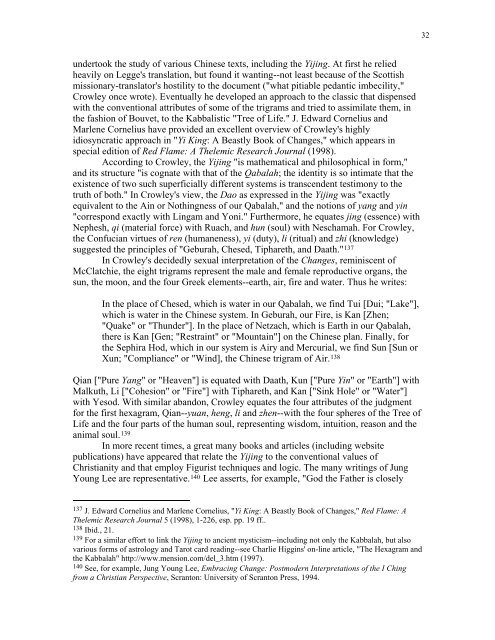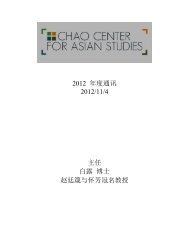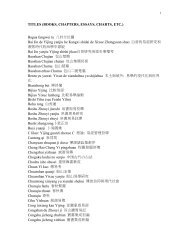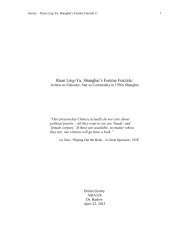Jesuit Interpretations of the Yijing - Chao Center for Asian Studies ...
Jesuit Interpretations of the Yijing - Chao Center for Asian Studies ...
Jesuit Interpretations of the Yijing - Chao Center for Asian Studies ...
Create successful ePaper yourself
Turn your PDF publications into a flip-book with our unique Google optimized e-Paper software.
32<br />
undertook <strong>the</strong> study <strong>of</strong> various Chinese texts, including <strong>the</strong> <strong>Yijing</strong>. At first he relied<br />
heavily on Legge's translation, but found it wanting--not least because <strong>of</strong> <strong>the</strong> Scottish<br />
missionary-translator's hostility to <strong>the</strong> document ("what pitiable pedantic imbecility,"<br />
Crowley once wrote). Eventually he developed an approach to <strong>the</strong> classic that dispensed<br />
with <strong>the</strong> conventional attributes <strong>of</strong> some <strong>of</strong> <strong>the</strong> trigrams and tried to assimilate <strong>the</strong>m, in<br />
<strong>the</strong> fashion <strong>of</strong> Bouvet, to <strong>the</strong> Kabbalistic "Tree <strong>of</strong> Life." J. Edward Cornelius and<br />
Marlene Cornelius have provided an excellent overview <strong>of</strong> Crowley's highly<br />
idiosyncratic approach in "Yi King: A Beastly Book <strong>of</strong> Changes," which appears in<br />
special edition <strong>of</strong> Red Flame: A Thelemic Research Journal (1998).<br />
According to Crowley, <strong>the</strong> <strong>Yijing</strong> "is ma<strong>the</strong>matical and philosophical in <strong>for</strong>m,"<br />
and its structure "is cognate with that <strong>of</strong> <strong>the</strong> Qabalah; <strong>the</strong> identity is so intimate that <strong>the</strong><br />
existence <strong>of</strong> two such superficially different systems is transcendent testimony to <strong>the</strong><br />
truth <strong>of</strong> both." In Crowley's view, <strong>the</strong> Dao as expressed in <strong>the</strong> <strong>Yijing</strong> was "exactly<br />
equivalent to <strong>the</strong> Ain or Nothingness <strong>of</strong> our Qabalah," and <strong>the</strong> notions <strong>of</strong> yang and yin<br />
"correspond exactly with Lingam and Yoni." Fur<strong>the</strong>rmore, he equates jing (essence) with<br />
Nephesh, qi (material <strong>for</strong>ce) with Ruach, and hun (soul) with Neschamah. For Crowley,<br />
<strong>the</strong> Confucian virtues <strong>of</strong> ren (humaneness), yi (duty), li (ritual) and zhi (knowledge)<br />
suggested <strong>the</strong> principles <strong>of</strong> "Geburah, Chesed, Tiphareth, and Daath." 137<br />
In Crowley's decidedly sexual interpretation <strong>of</strong> <strong>the</strong> Changes, reminiscent <strong>of</strong><br />
McClatchie, <strong>the</strong> eight trigrams represent <strong>the</strong> male and female reproductive organs, <strong>the</strong><br />
sun, <strong>the</strong> moon, and <strong>the</strong> four Greek elements--earth, air, fire and water. Thus he writes:<br />
In <strong>the</strong> place <strong>of</strong> Chesed, which is water in our Qabalah, we find Tui [Dui; "Lake"],<br />
which is water in <strong>the</strong> Chinese system. In Geburah, our Fire, is Kan [Zhen;<br />
"Quake" or "Thunder"]. In <strong>the</strong> place <strong>of</strong> Netzach, which is Earth in our Qabalah,<br />
<strong>the</strong>re is Kan [Gen; "Restraint" or "Mountain"] on <strong>the</strong> Chinese plan. Finally, <strong>for</strong><br />
<strong>the</strong> Sephira Hod, which in our system is Airy and Mercurial, we find Sun [Sun or<br />
Xun; "Compliance" or "Wind], <strong>the</strong> Chinese trigram <strong>of</strong> Air. 138<br />
Qian ["Pure Yang" or "Heaven"] is equated with Daath, Kun ["Pure Yin" or "Earth"] with<br />
Malkuth, Li ["Cohesion" or "Fire"] with Tiphareth, and Kan ["Sink Hole" or "Water"]<br />
with Yesod. With similar abandon, Crowley equates <strong>the</strong> four attributes <strong>of</strong> <strong>the</strong> judgment<br />
<strong>for</strong> <strong>the</strong> first hexagram, Qian--yuan, heng, li and zhen--with <strong>the</strong> four spheres <strong>of</strong> <strong>the</strong> Tree <strong>of</strong><br />
Life and <strong>the</strong> four parts <strong>of</strong> <strong>the</strong> human soul, representing wisdom, intuition, reason and <strong>the</strong><br />
animal soul. 139<br />
In more recent times, a great many books and articles (including website<br />
publications) have appeared that relate <strong>the</strong> <strong>Yijing</strong> to <strong>the</strong> conventional values <strong>of</strong><br />
Christianity and that employ Figurist techniques and logic. The many writings <strong>of</strong> Jung<br />
Young Lee are representative. 140 Lee asserts, <strong>for</strong> example, "God <strong>the</strong> Fa<strong>the</strong>r is closely<br />
137 J. Edward Cornelius and Marlene Cornelius, "Yi King: A Beastly Book <strong>of</strong> Changes," Red Flame: A<br />
Thelemic Research Journal 5 (1998), 1-226, esp. pp. 19 ff..<br />
138 Ibid., 21.<br />
139 For a similar ef<strong>for</strong>t to link <strong>the</strong> <strong>Yijing</strong> to ancient mysticism--including not only <strong>the</strong> Kabbalah, but also<br />
various <strong>for</strong>ms <strong>of</strong> astrology and Tarot card reading--see Charlie Higgins' on-line article, "The Hexagram and<br />
<strong>the</strong> Kabbalah" http://www.mension.com/del_3.htm (1997).<br />
140 See, <strong>for</strong> example, Jung Young Lee, Embracing Change: Postmodern <strong>Interpretations</strong> <strong>of</strong> <strong>the</strong> I Ching<br />
from a Christian Perspective, Scranton: University <strong>of</strong> Scranton Press, 1994.








